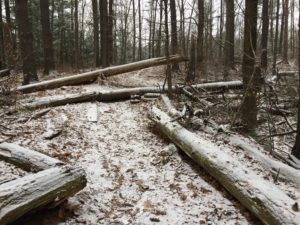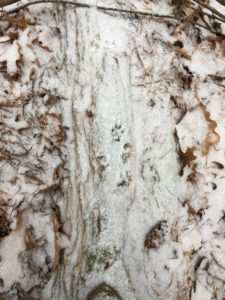The land has noticably thawed, movement is coming back to the land. Everything seems wet and all the dead trees are waterlogged and the remaining snow melts on top of it. Birds can be heard in the distance signifying the lands slow wake from its slumber. Buds can be abserved peaking out of the maple and beech branches low to the ground. The moist smell of spring lingers in the air
The woods are almost silent. This is the most significant change. The forest is sitting still under the blanket of snow with only the occasional movement by criters such as squirrels when it isint too cold for them. There is plenty of shelter for critters like this in this part of the forest. Under all the leaves, sticks and logs I’m sure plenty of life lay dormant. Creatures are still showing themselves though. The animal tracks all over the place is evidence of this.
Posted in Uncategorized | Leave a Comment »
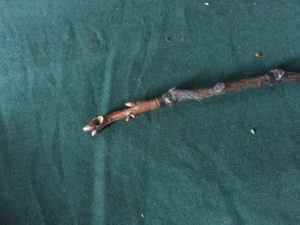
This is a twig from the red oak tree next to the path. The end of the twig is a reddish color with short buds.
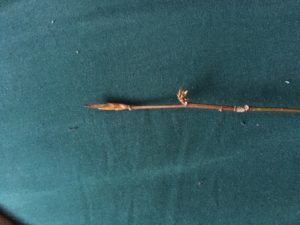
This twig is from a short beech tree. It can be characterized by its destinctively long bud “cigar” buds.
Posted in Uncategorized | Leave a Comment »

Squirrel tracks on a log.
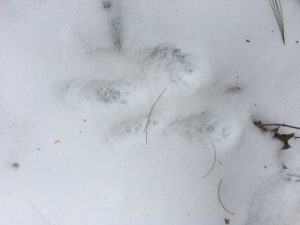
Squirrel track as it runs to a different tree.
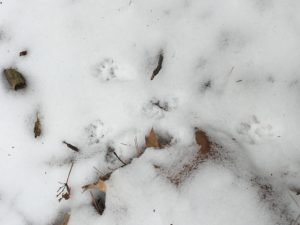
More squirrel tracks.
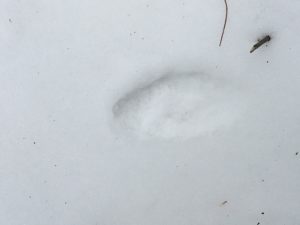
Suspected porcupine track.
Posted in Uncategorized | Leave a Comment »
The most common track found in the area is the gray squirrel track. They can be seen clearly traveling over and under logs from tree to tree where the tracks disapear then start again on the other side of the tree trunk. The squirrels are looking for food sources to keep them going through the winter. A set of what looked like porcupine tracks crossed along the trail and went down the hill towards a grove of hemlock trees although the tracks were difficult to decipher. I believe they were porcupine tracks because hemlock is a known food source of the porcupine in winter months.
Posted in Uncategorized | Leave a Comment »

This picture shows the reciting pine trees on the bottom of the hill surrounded by dead pines and hardwoods like maple and oak making their way down the hill.
Posted in Uncategorized | Leave a Comment »
This part of centennial woods is thick with pine trees. Pine trees tend to grow in open areas which is evident that this part of the forest was cleared land however many years. It was most likely farmland in the past. These pine trees are being outcompeted by other hardwood trees which are more prominent farther up the hill. These hardwoods such as maple and oak seem to be growing in the understory of the oaks while the oaks are all falling down with no saplings to replace them. This shows that the forest is currently undergoing succession as a result of its former clearing. This land was most likely used for grazing candle but could have been used for any kind of agriculture.
Posted in Uncategorized | Leave a Comment »

The shadowy scar from the fire can be seen at the base of the living trees.


Evidence that there was some sort of fire here.
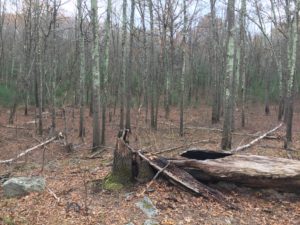
This is the log that I believe started the fire. The green ring I described can be seen in the background.
Posted in Uncategorized | Leave a Comment »
This part of the woods looks like a graveyard. Skinny dead trees covered in char litter the ground making walking off the beaten path a challenge. The Surviving trees are only thick oaks with shadowy scars at their feet explaining why they might be the only ones left. A green wall of short pines on the horizon surrounds the graveyard offering the only source of color other than grey. Shrubby beech trees are the only low level trees and stand no taller than myself. The openness of the leafless forest invites the wind to cut right through making it feel like you’re in an open field. There is complete silence save the occasional push of wind suggesting that the local wildlife likely took the day off due to the cold. An enormous log a few feet in diameter lays across the trail. This log is significantly larger than any of the other dead trees that lay on the ground and if it were still standing it would be among the tallest and thickest in the forest. Its bottom is completely burnt and removed from the ground. This inconsistency in the pattern could explain the what happened in the forest. However many years ago during a lightning storm, this tree was likely struck by lightning and knocked over. This caused the fire that killed any tree smaller than the 8 inch diameter oak trees that are hearty enough to withstand a fire. They only suffered scarring at their bases where the flame was exposed to them.
Posted in Uncategorized | Leave a Comment »

